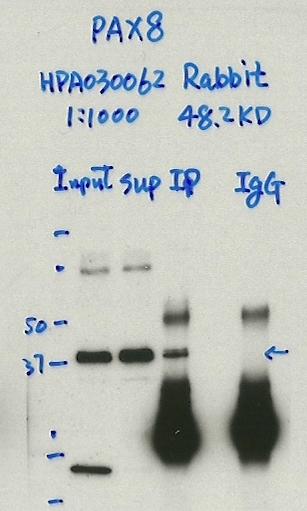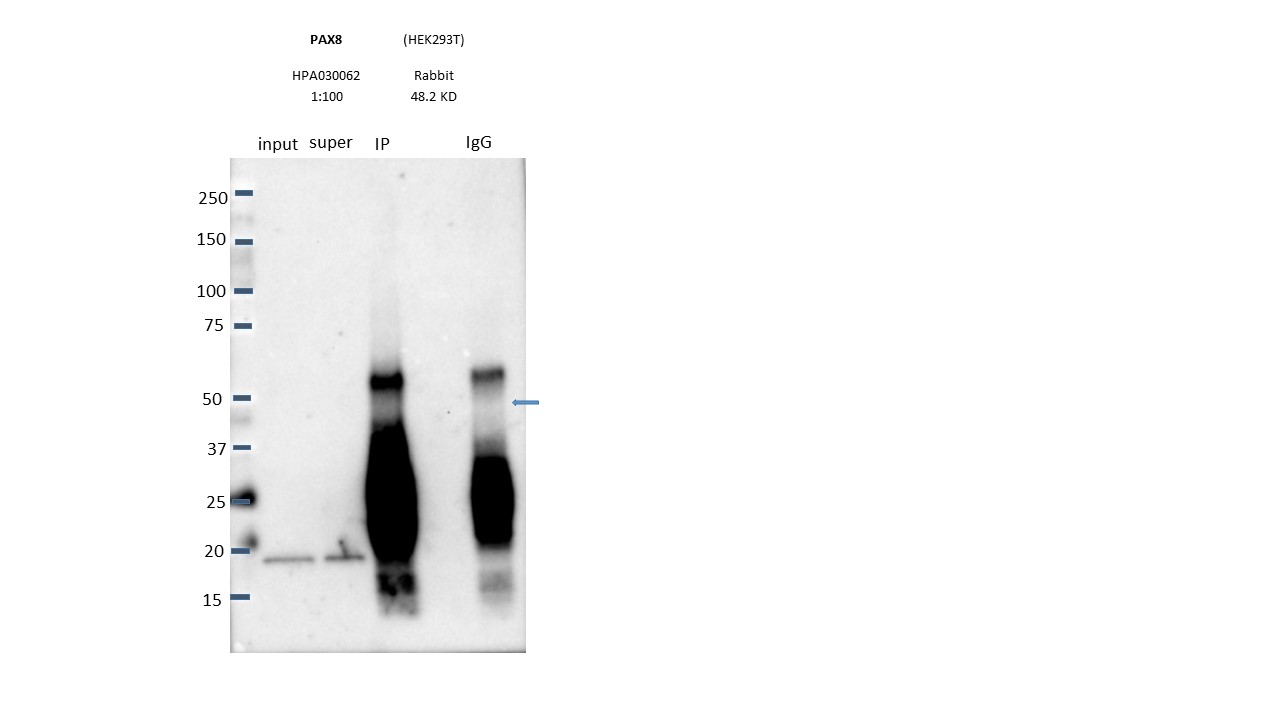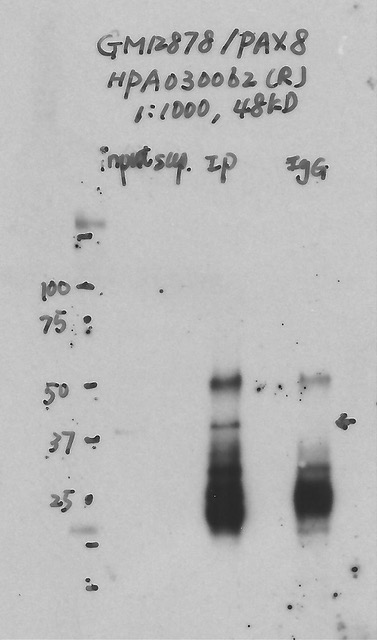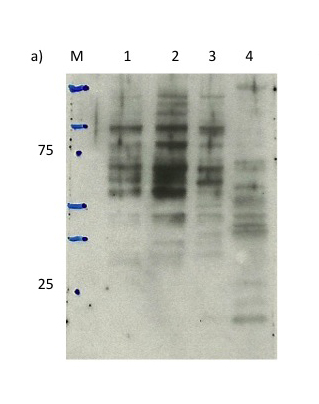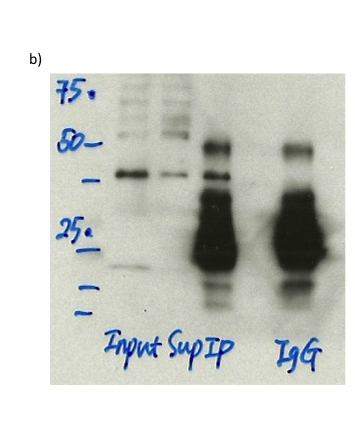ENCAB000BOS
Antibody against Homo sapiens PAX8
Homo sapiens
GM12878, K562, HepG2, MCF-7
characterized to standards
Homo sapiens
any cell type or tissue
partially characterized
Homo sapiens
liver
not characterized to standards
- Status
- released
- Source (vendor)
- Sigma
- Product ID
- HPA030062
- Lot ID
- A82758
- Characterized targets
- PAX8 (Homo sapiens)
- Host
- rabbit
- Clonality
- polyclonal
- Purification
- affinity
- Isotype
- IgG
- Antigen description
- Paired box 8 recombinant protein epitope signature tag (PrEST)
- Antigen sequence
- QPFNLPMDSCVATKSLSPGHTLIPSSAVTPPESPQSDSLGSTYSINGLLGIAQPGSDKRKMDDSDQDSCRLSIDSQ
- External resources
Characterizations
PAX8 (Homo sapiens)
MCF-7
compliant
- Caption
- Immunoprecipitation was performed on nuclear extracts from the cell line: MCF-7, using the antibody HPA030062. The blot shows western blot analysis of input, flowthrough, immunoprecipitate and mock immunoprecipitate using IgG.Molecular Weight: 48.2
- Submitted by
- Denis Salins
- Lab
- Michael Snyder, Stanford
- Grant
- U54HG006996
- Download
- 1093_12_PAX8_HPA030062.jpg
PAX8 (Homo sapiens)
Method: motif enrichment
compliant
- Caption
- The motif for target PAX8 is represented by the attached position weight matrix (PWM) derived from ENCFF455YHJ. Motif enrichment analysis was done by Dr. Zhizhuo Zhang (Broad Institute, Kellis Lab) using known motifs (http://compbio.mit.edu/encode-motifs/) and previously published ChIP-seq data (http://www.broadinstitute.org/~zzhang/motifpipeline/data/TrainSetInfo.txt). The accept probability score of the given transcription factor was calculated using a Bayesian approach. This analysis also includes three motif enrichment scores, computed by overlapping the motif instances with the given ChIP-seq peak locations, as well as an enrichment rank. For more information on the underlying statistical methods, please see the attached document. Accept probability score: 0.622305554931 Global enrichment Z-score: 8.99046771753 Positional bias Z-score: 5.62807996875 Peak rank bias Z-score: 6.27757558625 4 Enrichment rank: 1.0
- Submitted by
- Jessika Adrian
- Lab
- Michael Snyder, Stanford
- Grant
- U54HG006996
PAX8 (Homo sapiens)
HepG2
compliant
- Caption
- Immunoprecipitation was performed on nuclear extracts from the cell line: HepG2, using the antibody HPA030062. The blot shows western blot analysis of input, flowthrough, immunoprecipitate and mock immunoprecipitate using IgG.Molecular Weight: 48.2
- Submitted by
- Denis Salins
- Lab
- Michael Snyder, Stanford
- Grant
- U54HG006996
- Download
- Expt1039_0003.jpg
PAX8 (Homo sapiens)
not submitted for review by lab
- Caption
- Immunoprecipitation was performed on nuclear extracts from the cell line: HEK293T, using the antibody HPA030062. The blot shows western blot analysis of input, flowthrough, immunoprecipitate and mock immunoprecipitate using IgG.Molecular Weight: 48.2
- Submitted by
- Nathaniel Watson
- Lab
- Michael Snyder, Stanford
- Grant
- U54HG006996
- Download
- Expt1123_5-PAX8-HPA030062.jpg
PAX8 (Homo sapiens)
GM12878
compliant
- Caption
- Immunoprecipitation was performed on nuclear extracts from the cell line: GM12878, using the antibody HPA030062. The blot shows western blot analysis of input, flowthrough, immunoprecipitate and mock immunoprecipitate using IgG.Molecular Weight: 48.2
- Reviewer comment
- Multiple bands and marked band is <50% of total signal in lane. Marked band also not seen in input lane.
- Submitted by
- Denis Salins
- Lab
- Michael Snyder, Stanford
- Grant
- U54HG006996
- Download
- GM-PAX8.jpeg
PAX8 (Homo sapiens)
GM12878K562HepG2liver
not compliant
- Caption
- a) Western blot analysis of nuclear lysates prepared from multiple cells lines loaded in the order: GM12878, K562, HepG2, Liver using the antibody HPA030062. Molecular mass: 48218 Da
- Reviewer comment
- Multiple bands with none making up >50% of the total signal.
- Submitted by
- Trupti Kawli
- Lab
- Michael Snyder, Stanford
- Grant
- U54HG006996
- Download
- PAX8_HPA030062_WB_a.jpg
PAX8 (Homo sapiens)
K562
compliant
- Caption
- b) Immunoprecipitation was performed on nuclear extracts from the cell line: K562, using the antibody HPA030062 .The blot shows western blot analysis of input, flowthrough, immunoprecipitate and mock immunoprecipitate using IgG. Expected size ~48 kDa.
- Submitted by
- Trupti Kawli
- Lab
- Michael Snyder, Stanford
- Grant
- U54HG006996
- Download
- PAX8_HPA030062_WB_b.jpg

